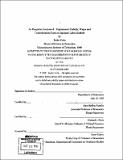An empirical analysis of employment stability, wages and unemployment rates of Japanese labor markets
Author(s)
Ueda, Keiko
DownloadFull printable version (11.12Mb)
Other Contributors
Massachusetts Institute of Technology. Dept. of Economics.
Advisor
Jörn-Steffen Pischke and Michael J. Piore.
Terms of use
Metadata
Show full item recordAbstract
This paper carries out an empirical analysis of Japanese labor markets with special attention paid on the comparison with the US labor markets. Chapter 1 studies how employment stability changed by measuring historical five-year retention rates for male regular workers grouped by education level and firm size. It was found that the overall retention rates began to decrease at the current recession after the long period of stability. Owing to the law prohibiting the mandatory retirement before the age of 60, the retention rate from 50-54 years old to 55-59 years old increased. However, the retention rates decreased for younger workers. A comparative study of retention rates between Japan and the US is also carries out. Chapter 2 shows how wage structure changed from 1974 to 93 by a great increase of old and more-educated male workers. Three kinds of wage differential - by age, by education level and by firm size - were examined. It was found that the young and less educated lost the ground most compared with the more educated and old. This finding is qualitatively the same with what happened in the US. The important difference is that the change of wage structure was much smaller in Japan than in the US. A simple supply-demand framework was applied to see how the wage and employment level were determined in the labor market. It was found that demand increase took place favoring senior and more educated workers and it raised the relative wage of more educated and more experienced like in the US. Chapter 3 shows that unemployment rate has been low and stable in Japan for a long time. One reason of this is that employment fluctuation is small. The second important reason is that larger part of employment fluctuation is shared by those who move between employment and out of the labor force without experiencing unemployment compared with the US. Women, teenagers and old share larger part of employment fluctuation, and they are more prone to be discouraged workers than other demographic groups. The unemployment rate is estimated when these discouraged workers are counted as unemployed.
Description
Thesis (Ph.D.)--Massachusetts Institute of Technology, Dept. of Economics, 1999. Includes bibliographical references.
Date issued
1999Department
Massachusetts Institute of Technology. Department of EconomicsPublisher
Massachusetts Institute of Technology
Keywords
Economics.